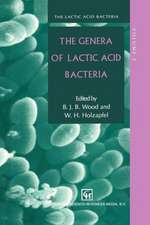Introduction to the Chemistry of Food
Autor Michael Zeeceen Limba Engleză Paperback – 3 feb 2020
- Describes the major and minor components of food
- Explains the functional properties contributed by proteins, carbohydrates and lipids in food
- Explores the chemical and enzymatic reactions affecting food attributes (color, flavor and nutritional quality)
- Describes the gut microbiome and influence of food components on its microbial population
- Reviews major food systems and novel sources of food protein
Preț: 379.50 lei
Preț vechi: 512.42 lei
-26% Nou
Puncte Express: 569
Preț estimativ în valută:
72.63€ • 75.54$ • 59.96£
72.63€ • 75.54$ • 59.96£
Carte tipărită la comandă
Livrare economică 08-22 aprilie
Preluare comenzi: 021 569.72.76
Specificații
ISBN-13: 9780128094341
ISBN-10: 0128094346
Pagini: 430
Dimensiuni: 152 x 229 x 21 mm
Greutate: 0.58 kg
Editura: ELSEVIER SCIENCE
ISBN-10: 0128094346
Pagini: 430
Dimensiuni: 152 x 229 x 21 mm
Greutate: 0.58 kg
Editura: ELSEVIER SCIENCE
Public țintă
Students in food science, nutritional sciences, public policy, and culinary arts. It also provides information to food entrepreneurs and individuals in the business of foodCuprins
Topic Outline
Water
Flavors
Water
- Physical and chemical properties of water
- Fundamentals of acid base chemistry
- Importance of water to food texture, flavor, and the preservation of food
- Examples of weak acids and their function in food.
- Structure of proteins
- Chemical properties of proteins
- Protein denaturation
- Nutritional properties of proteins (digestibility evaluation, essential amino acids)
- Food allergy
- Functional properties of proteins (solubility, foaming, gelation)
- Examples of enzymes in foods
- Structure and nomenclature of carbohydrates (monosaccharides, oligosaccharides, and polysaccharides)
- Maillard chemistry, its importance to color, flavor, and undesirable products in food
- Food intolerances, lactose and other FODMAPS
- Nutritional aspects of carbohydrates (dietary fiber, effect of starch structure on glycemic index)
- Functional properties of carbohydrates (solubility, gelation, viscosity, sweetness)
- Polysaccharides starch, cellulose, gums, and other hydrocolloids
- Structure and nomenclature of fatty acids, acylglycerols and sterols
- Importance of lipid (fat) structure to functional and physical properties in food
- Chemistry of lipid hydrogenation and how trans fats occur in food
- Lipid oxidation chemistry
- Antioxidants and how they control lipid oxidation
- Lipids of importance to health (essential fatty acids, ω6 to ω3 ratio)
- Definition of a micronutrient
- Nutritional food labeling
- Chemical properties of vitamins and minerals
- Biological importance
- Supplementation and means of loss
Flavors
- The elements of taste and nature of its receptors
- Sweet, bitter, sour, umami, and salty tastants
- The gustatory taste map
- Sugar substitutes and questions of their contribution to health
- Smell and olfactory perception
- Pungency
- Flavor is in the brain, not food
- Use and regulation of food additives
- Synthetic vs natural additives
- Examples of additive use in foods
- Food toxins and toxicants, a case of inadvertent food additives
- Use and regulation of food colorants
- Synthetic vs natural food colorants
- Properties of natural colorants
- Examples of natural substances as replacements for synthetic colorants
- Gut microbiome and its contribution to health
- Influence of food components on the microbiome
- Major food systems and their composition
- Properties of protein-rich plant and microbial foods
- Novel plant-based animal foods



























